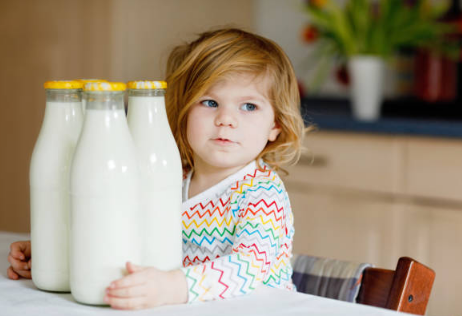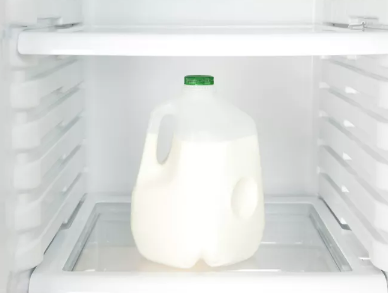Transitioning your baby from breast milk or formula to cow’s milk can be an exciting milestone. But just like the introduction of solid food, it is important to wait until the baby is ready. This is especially true for milk, which can only be drunk after a child’s first birthday.
It is crucial that your baby does not drink milk until they are 12 months old, as it takes time for their digestive system to develop to process milk effectively. Learn more about when and how to introduce whole milk into your baby’s diet.

When to Add Milk to Your Baby?
Your child may be ready to drink their first glass of whole milk after they are one year old, but not yet. Babies under the age of 12 months are unable to digest the extra minerals, proteins, and sodium in cow’s milk. In addition, breast milk or formula provides ideal nutrition for babies in their first year. That’s why it’s advisable to wait until after their first birthday to give them milk.
How to Introduce Milk?
After your child’s first birthday, try giving your baby a glass of whole milk for dinner or snack time. You can also put it in a bottle. Still, it’s advisable to start abstaining from bottles at 12 to 18 months of age, so you’ll start using cups soon. Many children love the taste of milk, have a lot of fun with the cups, and will enjoy it!
“Served in a cup; I usually recommend using a straw,” says Ali Brown, MD, a pediatrician in Austin, Texas and author of the Baby 411 series. “And I don’t recommend that kids use cups or sippy cups 24/7. Milk is provided at the time of meals and snacks.”
Choose whole milk for your baby instead of low-fat milk. Babies and toddlers need the extra fat in whole milk for brain development. For young children over 2 years of age, it is usually recommended to switch to milk with a lower fat content, such as 2% or skim milk. However, it is best to consult your child’s doctor, as individual growth patterns and nutritional needs vary.
How Much Milk Does Your Baby Need?
According to the USDA, toddlers under the age of 2 only need 16 ounces (or 2 cups) of whole milk per day. From 2 to 5 years old, it is recommended to switch to 2 to 3 cups per day.
“Remember, kids don’t have to drink milk like they drink bottles,” Dr. Brown said. “Milk is now a beverage and a supplement to solid food. It is no longer a meal per se, like a bottle of yesteryear.”
Should I Continue to Drink Breast Milk or Formula?
Breast milk and cow’s milk can be provided to breastfed infants over 1 year of age if needed. In fact, the World Health Organization (WHO) encourages breastfeeding up to 2 years of age or older. But formula is no longer needed after age 1, and the American Academy of Pediatrics (AAP) doesn’t recommend formula for young children. Between toddler formula and cow’s milk, cow’s milk is a healthier choice for young children.
Nutritional Benefits of Milk for Children over 1 Year of Age
Milk contains key bone-building nutrients such as calcium, riboflavin, vitamin D, and protein. Essentially, drinking enough milk can help your child grow and reach maximum height.
Dairy products also contain vitamin A, which helps promote healthy vision and immune function. It is also a good source of phosphorus, which promotes healthy nerve conduction, energy utilization, and muscle recovery.

Although children can get these nutrients through other foods, milk is one of the easiest ways to do it because it’s readily available, nutritious, and relatively inexpensive.
What if My Baby Doesn’t like the Taste?
It may take a while for your baby to get used to drinking milk. If they’re interested in the taste of whole milk, try mixing it with breast milk or formula to help them learn about the new taste. (If you use powdered milk or concentrated liquid formula, prepare the formula as usual before adding to milk; do not use milk instead of water to prepare the formula.)
You can start by mixing equal portions (half milk and half breast milk or formula). Over time, reduce the amount of breast milk or formula and increase the amount of milk until you drink only cow’s milk.
You can also try out how to provide it. Try to consume it at room temperature, slightly warm, or cold. Or try putting it in a fun new cup. Be patient as it may take a few days or weeks for your baby to get used to this new taste.
How to Solve the Problem of Milk Allergy?
Most babies will be fine with cow’s milk, but watch for signs of allergies, as cow’s milk protein is a common allergen in infants and young children. Symptoms of an allergy to cow’s milk include swollen lips, hives, vomiting, crying, or blood in the stool.
In the case of allergies, these symptoms appear immediately or shortly after your baby is exposed to milk. If your child is already drinking soy formula or hypoallergenic formula, talk to your pediatrician before adding milk. The good news is that most children begin to be allergic free by the age of 2. Often, pea protein, oats, hemp, almonds, or other plant-based milks that contain vitamin D and calcium are common alternatives for children with cow’s milk allergies.

What to Do About Milk Intolerance?
How is intolerance different from allergies? Babies who are intolerant to cow’s milk have difficulty digesting milk. They experience gastrointestinal symptoms such as bloating, gas, or loose stools, rather than an immediate immune response triggered by an allergy.
Cow’s milk intolerance is caused by the inability to digest lactose (the sugar naturally found in milk) into simple sugars. Supplement the diet of lactose intolerant children with other sources of calcium and vitamin D to ensure their healthy development. Some of the options recommended by the American Academy of Pediatrics include lactose-free dairy products and fortified soy milk. Also keep in mind that many children with lactose intolerance are able to consume small amounts of dairy products without experiencing any symptoms.
Conclusion
Drinking milk promotes healthy growth and development in older infants and young children. Whole cow’s milk can be used instead of breast milk or formula at age 1 year, but not before. After the baby’s first birthday, breastfeeding can continue in addition to introducing cow’s milk as needed, but after one year of age, formula milk is no longer recommended.
